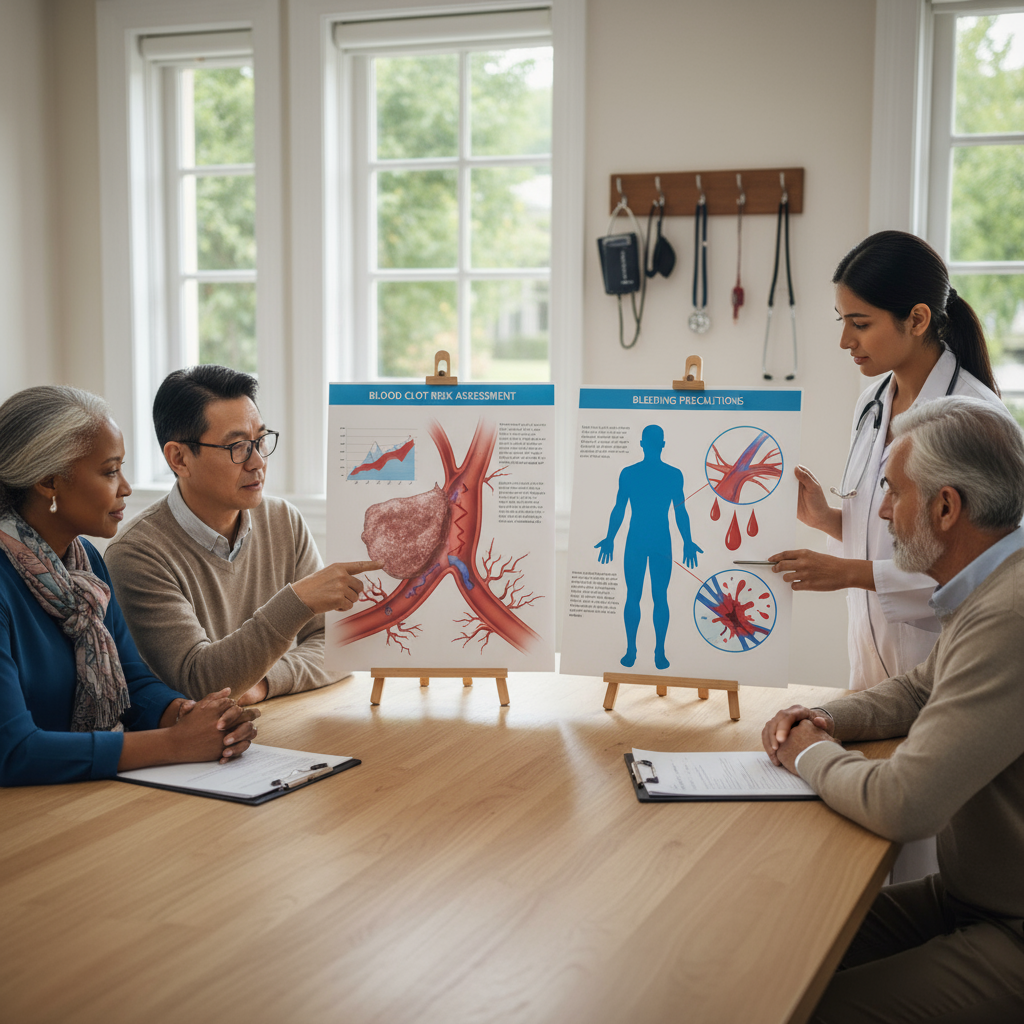Highlight
– Rivaroxaban monotherapy demonstrated reduction in major cardiovascular events compared to combination therapy across age groups.
– Significant bleeding risk reduction was observed, notably in younger patients (<70 years).
– Older patients (≥80 years) showed the greatest efficacy benefit with rivaroxaban monotherapy.
– Findings suggest age-related differential trends in efficacy and safety, generating hypotheses for further study.
Study Background and Disease Burden
Atrial fibrillation (AF) and coronary artery disease (CAD) frequently coexist, especially in older adults. This overlap presents a clinical challenge due to the competing risks of thromboembolism and bleeding. AF increases stroke risk, whereas CAD requires antiplatelet therapy to prevent ischemic events. Balancing anticoagulation with antiplatelet therapy is crucial, given that combined regimens elevate bleeding risk significantly in this vulnerable population.
Rivaroxaban, a direct oral anticoagulant (DOAC), has proven effective for stroke prevention in AF. However, its optimal use alongside or without antiplatelet agents in stable CAD with AF remains debated. Older patients, who constitute a growing demographic in cardiovascular care, especially require tailored strategies due to heightened bleeding and ischemic risks. The AFIRE trial initially demonstrated that rivaroxaban monotherapy was noninferior to rivaroxaban combined with antiplatelet therapy for efficacy and superior in safety. This post hoc analysis aimed to explore whether age modifies these effects.
Study Design
This secondary analysis of the AFIRE trial investigated the age-stratified effects of rivaroxaban monotherapy versus rivaroxaban plus antiplatelet combination therapy. AFIRE was a multicenter, open-label randomized clinical trial conducted in Japan between February 2015 and July 2018.
Eligible patients had AF and stable CAD, defined as having undergone percutaneous coronary intervention or coronary artery bypass grafting at least 1 year prior or angiographically confirmed CAD not requiring revascularization. Participants were randomized to receive either rivaroxaban monotherapy or rivaroxaban plus an antiplatelet agent.
For this analysis, 2215 patients were stratified into four age groups: under 70 years, 70 to 74 years, 75 to 79 years, and 80 years or older. The main efficacy endpoint was a composite of major adverse cardiovascular events (MACE), including stroke, systemic embolism, myocardial infarction, unstable angina needing revascularization, or all-cause death. The primary safety endpoint was major bleeding. Data were analyzed from August 2024 to July 2025.
Key Findings
The overall cohort had a mean age of 74.3 years with 79.1% male participants.
Primary Efficacy Endpoint (MACE):
- For patients <70 years, incidence rates per patient-year were 3.2% with monotherapy vs 4.3% with combination therapy (hazard ratio [HR] 0.74; 95% CI, 0.40-1.37).
- Aged 70-74 years showed similar rates 3.2% vs 2.8% (HR 1.16; 95% CI, 0.55-2.45).
- Aged 75-79 years had 3.8% vs 5.3% (HR 0.72; 95% CI, 0.41-1.26).
- In patients ≥80 years, monotherapy conferred a significant reduction: 6.2% vs 10.3% (HR 0.61; 95% CI, 0.40-0.93).
The P-value for interaction was 0.51, indicating no statistically significant heterogeneity in treatment effect by age but with visually notable trends.
Primary Safety Endpoint (Major Bleeding):
- In patients younger than 70 years, major bleeding incidence was markedly lower with rivaroxaban monotherapy (0.5%) compared to combination therapy (2.3%) (HR 0.23; 95% CI, 0.06-0.79).
- For age 70-74 years, bleeding rates were comparable (2.2% vs 2.4%; HR 0.91; 95% CI, 0.39-2.15).
- Patients aged 75-79 years showed a nonsignificant trend favoring monotherapy (1.1% vs 2.1%; HR 0.52; 95% CI, 0.19-1.42).
- Those ≥80 years had a higher incidence overall but a lower rate with monotherapy (2.9% vs 4.3%; HR 0.67; 95% CI, 0.35-1.27).
The interaction test (P=0.33) did not reach statistical significance but suggested possible age-related safety differences.
Interpretation: Rivaroxaban monotherapy reduced major cardiovascular event risk consistently across age groups, with the most pronounced benefit seen in the oldest patients (≥80 years). In contrast, bleeding risk reduction was greatest and statistically significant in the youngest group. Middle age groups showed intermediate or nonsignificant differences. These results underscore a complex balance between efficacy and safety that may shift with age.
Expert Commentary
The AFIRE age-stratified analysis extends knowledge on managing AF with stable CAD in an aging population. Older adults, who often bear both high thrombotic and bleeding risk, may benefit from rivaroxaban monotherapy, reducing polypharmacy without compromising ischemic protection. Younger patients gain significant bleeding risk reduction, enhancing safety profiles.
Current guidelines (e.g. 2020 ESC, 2021 ACC/AHA/HRS) urge careful evaluation of bleeding risk but offer limited age-specific recommendations for combination versus monotherapy in stable CAD. These findings highlight the potential to tailor antithrombotic regimens by age, although randomized prospective studies focused on elderly cohorts remain necessary.
Limitations include the post hoc nature, Japanese population specificity, and open-label design, which may affect generalizability. Additionally, use of rivaroxaban dosing and concomitant medications varied, which could influence outcomes. Further mechanistic studies to elucidate age-related vascular and hemostatic changes are warranted.
Conclusion
Rivaroxaban monotherapy proved effective and generally safer than rivaroxaban plus antiplatelet therapy in patients with AF and stable CAD across a wide age range. The analysis suggests older patients (>80 years) might derive greater efficacy benefit, whereas younger patients experience pronounced bleeding risk reduction. These observations should be considered hypothesis-generating and encourage tailored anticoagulation strategies considering patient age. Future prospective research is required to confirm these findings and optimize therapy in this complex population.
References
- Yamaguchi J, Arashi H, Hagiwara N, et al; AFIRE Investigators. Age-Stratified Effect of Rivaroxaban Monotherapy for Atrial Fibrillation in Stable Coronary Artery Disease: A Post Hoc Analysis of the AFIRE Randomized Clinical Trial. JAMA Cardiol. 2025 Aug 13:e252611. doi:10.1001/jamacardio.2025.2611.
- January CT, Wann LS, Calkins H, et al. 2019 AHA/ACC/HRS Focused Update on Atrial Fibrillation: Executive Summary. Circulation. 2019;140(2):e125-e151.
- Roffi M, Patrono C, Collet JP, et al. 2015 ESC Guidelines for the management of acute coronary syndromes in patients presenting without persistent ST-segment elevation. Eur Heart J. 2016;37(3):267-315.
- Steffel J, Collins R, Antz M, et al. 2021 ESC Guidelines for the management of atrial fibrillation developed in collaboration with the EACTS. Eur Heart J. 2021;42(5):373-498.


